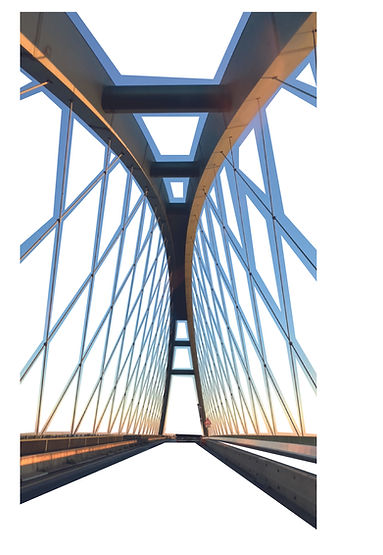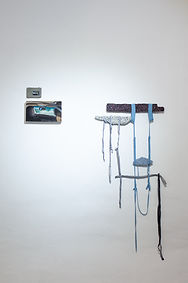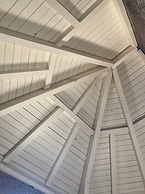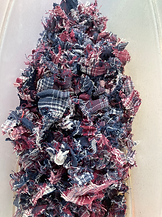
























looking: thinking about manmade objects in urban spaces - functional, formal, found, discarded, stretched, used

organic matter: growing, re-birth, new life, moving, breathing, absorbing











drawing: thinking about line, form, texture and positive/negative space





























weaving patterns: looking at historic weaving patterns as form, construction, line and shape








Wilson Road Residency: June
Unit 3 started with our move to Wilson Road, where we had four weeks to develop our work for the summer exhibition. Throughout Unit 2 I was concerned with form; thinking about ways I could apply the reclaimed clothing pulp to structures and spaces that was true to form, material and environment. Now in a new space, and one charged with a unique history, I knew I wanted to create work that was site-responsive in some way.
I began by walking around the space, looking and drawing different features of the building that I felt was an were 'in-between' spaces, which I had become interested in as places of temporality, movement, and fleeting encounters (much like our material relationships with clothing, and other objects of mass-consumption).
I was particularly interested in the corridors, doorways and windows, especially the repetitive grid structures of the windows. I also noticed the myriad of air vents around the outside of the building, all different styles as a hint of the many developments/upgrades the building has undergone over the years, and I began thinking about the bodily, organic matter that moves between our own bodies and the buildings we inhabit through these hidden networks and systems. In the same token, I was also interested in the pipes, which carry biological substances in a cyclical manner.
After spending time in the building, I decided to focus on the first floor corridor, with the semi-translucent window structures on the floor: looking up from the downstairs corridor, the movement of footsteps is visible but in an indistinct way. I thought about the corridor as a connecting space, where bodies cross paths, air flows freely, and where the functional form of the corridor could be challenged or disrupted.














































working on site























Wilson Road presented several successes and challenges for me. I felt I accomplished a lot in a short space of time - with the four-week timeframe from moving to the building to presenting the work - and knowing I wanted to make something site-specific, I had to work quickly and decisively. I enjoyed working in the space and I was able to really immerse myself in that environment, which enabled me to think about a lot of the concepts that had started to creep into my practice, around this idea of energy being transferred between body, space and material, the temporality of interaction and movement, and organic and inorganic growth and action.
The challenges for me really came down to what happened surrounding the sculptures, which, in part, was the challenge of making site-specific work. I found it difficult to cancel out the 'noise' of everything else that is populating the space. This isn't just true to other artworks in the space, but also the space itself. The linear quality of the work can then get lost against the backdrop of doors and fire extinguishers, for example.






air vent series: July
Having spent time walking around the interior and exterior of the building, I became increasingly more aware of the many air vents that were situated on the outside of the building and how they all varied slightly in shape and scale. After working with the grid forms in the corridor, I wanted to work in a much smaller scale, replicating the shapes of the air vent in the same irregular/organic way I worked in the corridor.


















.jpg)














In presenting the work I wanted to replicate the placement of the vents on the walls outside. I'm interested in the invisible network enclosed within the walls, and how the air vents act as this barrier, but also an opening. Whilst thinking about this energy of consciousness, I also thought about the pipes that carry air and water through the building, transferring energy into these spaces, and replicating natural forms in some way.




crop, around, organ, ground: August


I had made this bulbous form in Unit 2, with the intention of finishing it this term. I wasn't happy with how the work sat - the space where the lines came together at the base didn't feel right. I ended up cutting this section off, and I felt that it was much more interesting to have it resting on the thin, spindly legs that almost looked as if they went into the floor.It gave a top-heavy quality to the work, making it feel imbalanced, which I liked, and it emphasised the reaching quality of the arms at the top, giving the structure more energy.
I ended up covering the work in slightly more muted tones, but I think a shape with this much vitality would have benefited from colours that were a little bit more vibrant.
However, it sat alongside paintings in two different exhibitions and I think it was effective in how it interacted with the work around it.



3D drawing: August
Taking the grid on the floor I decided to up the scale of the drawings I had been making and move it into a 3-dimensional space, thinking about materials learning, evolving and growing. At first I crated a boulder type space that the drawing wrapped around and tried placing it both in the corridor and away from it. I think that because of the vast white spaces left in the drawing, I would need it to be much bigger to achieve the 'drawing in space' effect I was looking for. I was then reminded of the angular structure I made at the beginning of the course, and the spaces were very similar to that I had been working with. Using this linear sculpture as a plinth, I then placed the drawing on top; interested in how the two interact. Using a small fine-liner pen, the drawing is quite textured, trying to recreate some of the texture in the fabric pulp. However, when the two are placed together I feel as though they both lose some of that surface quality.















boardwalk repairs: August
For some time I've wanted to make work about the deteriorating boardwalk near my old house in Devon. The sculptural quality of the board walk as in hugs the undulating dunes, and repetitive marks of each board, and the weathered texture of the old wood combines a lot of the characteristics I find interesting in the work I'm trying to create. It feels like a collaboration between the land and the material, and the composition looks different from every angle. During lockdown in 2020 and 2021 I would walk along the board walk regularly, and have long had the idea of filling the spaces left by broken boards, but I didn't know how or with what.
This summer, I measured the spaces and rebuilt them using various garments. I had initially planned to exhibit the work as part of 'Unstable Ground' curated by Corinna Wagner, held at Studio KIND. (the gallery I run that backs onto the dunes). I trialled the work at Wilson Road ahead of the exhibition, but I wasn't sure that the presentation was effective enough to exhibit at this stage.























Writing
I thought about my mum’s blanket. A pale pink and white knitted blanket, with a strip of worn satin at each end. She called it her ‘susser’ blanket, and as a child she would run the blanket between her middle finger and index finger. This back and forth, repeated action, up and down the edge of the blanket, was a comfort to her; performed if she felt anxious or sad. I think about the fact she often describes her childhood as melancholic and lonely. And I think about this small, rhythmic movement of her fingers. How the satin must feel against the soft, sensitive skin of the hands, and how it must contrast from the slightly more abrasive wool of the 60s. I imagine the blanket adopted a lot of the sadness my mum felt as a child, when she held it. Folded and stored, the blanket is really just an anecdote now. I wonder where it will go when we die.
My partner’s Grandma crochets every day. She makes huge crocheted blankets in bright, clashing colours that she gifts to everyone she meets. She makes each one religiously, with love, as she sits in the living room; unable to sit still without the hook and yarn in her hands, doing the same rhythmic movements that she has done for years. Each row, each thread, imbued with her dedication, devotion, and impulse. When her husband became ill, she wrapped him with as many of her blankets as she could find. It dawned on me that it was her way of encompassing him in her love - more than her body would ever be able to do. Or perhaps she was imparting the life that exists in the blanket on to him. Perhaps it was an attempt to prolong life. The blanket, alive with energy that transferred from her hands, into the yarn, into the blanket, and it’s no longer an inanimate object, but instead a vibrating, living entity. I think about the warmth of our bodies, and how this energy gets caught between the gaps in the yarn, each strand warmed and sustained with our own thermal heat; layered and suspended in the lines of coloured wool.
shift: September
I had a collection of old work that I didn't like/was unfinished and I didn't want to throw anything away, so I thought I'd see if I could re-use the fabric somehow; either by breaking it down again or re-hydrating it. Ripping it apart by hand was possible, but not entirely easy. Once it was in 2-3 inch pieces I added water so that the fabric was just submerged and let it sit for 5-6 hours. When I returned the material had mostly disintegrated into the water, and I finished breaking it up by hand so that it was an even consistency. It was exactly like when I first mix the material and I was able to re-apply it to the metal framework just as I had done previously - with it drying exactly the same.
This really opened up several doors to me: one was that I no longer had to be as precious with the material as I had been before. With it taking such a long time to cut up the fabric, I had lost a kind of looseness and freedom - having to take a more considered approach that was less instinctive than I would like. Then meant I could still test/experiment without the worry of waste (wasted time and material). The second was that I had added a whole other cycle of sustainability to the work - recycling clothes into an art material, and then breaking down the sculptures and re-forming them infinitely. Renewability is engrained within my practice, and the ability to continue this process of reuse was a really important development for me.




Using a metal and wire frame I made in Unit 2 I started to apply the re-hydrated material - this time layering up different materials. This is a departure from my previous work where I would keep the garments in 'blocks' so each colour represented the mass of a body in some way. I also cut out sections of the metal wire, which broke up the grid formation and had a sense of decay and deterioration, enhanced by the broken up fabric. I also like the sense of imbalance of the sculpture, and the top-heavy quality.
I think there are some successful sections of the work but I would like to keep building on it and see how far I can go with the layering and building - perhaps in a way that messes up the grid format even more.





pipe: September
Following on from the work with the air vents at Wilson Road I wanted to try making some forms that were inspired by pipes, which I had done some drawings of a couple of months previously.
I left sections of the steel rods longer than necessary with the intention of cutting them off after I had welded it together. However, these extensions became a key part of the work and really played into the idea of materials taking on their own life forms and moving away from the formal structures of man-made objects/systems.


AMP Gallery with Fergus Channon: October
Ebb and Flow,
Fergus Channon and Laura Porter
AMP Gallery
1 Acorn Parade, Peckham, SE15 2TZ
11th – 16th October 2022, 12-6pm
Private view: Saturday 15th October, 6-9pm
Through their process-driven approaches to making, painter Fergus Channon and sculptor Laura Porter are bringing together new works in ‘Ebb and Flow’ at AMP Gallery this October. Fergus and Laura find a commonality in their interest in the physicality of making and the traces left by the body through these repetitive movements, whilst finding inspiration in built and inhabited space where a distorted sense of familiarity is apparent.
Both artists push the boundaries of the material cultures within their own practices, questioning the application of painting, the repurposing of found objects, and the systematic removal and reapplication of material properties: finding a compromise between artist and art object, and relinquishing control throughout the process allows chance and accident to inform the end product.
The labour involved in both practices can often become an invisible presence within the work, and the work meets at the point where the complex and simple comes together.
‘Ebb and flow’ refers to how we gain ground and then in turn lose ground; how we find our way by retracing steps; how our processes offer original approaches whilst restricting us; and how the balance and belief in these processes sustain us. A recurrent pattern of coming and going - decline and regrowth.
Laura Porter’s practice addresses the way we interact with space and materials through a simultaneous absence and presence of the body. Imagining a world void of humankind, where our debris forms a new consciousness that grows and shifts like the natural world in which is exists, Laura’s practice uses multiplicity and repetitive processes representative of mass production, in juxtaposition with hand-made and artisanal sensitivities to create a continuous tension indicative of the dichotomy of the individual versus the group. Exploring ideas of personal responsibility versus collective encounters, these regularly repeating acts address the patterns and systems that regulate life, and the in-betweenness of space and body amongst natural and built environments.
Fergus Channon’s practice explores the rhythms of the inevitable passing of time, observing the incremental changes that often go unnoticed and unappreciated. His interest in materiality and process-led painting allows him to discover new painting techniques, the playful methodology determining the aesthetic of the image. He manipulates the traditions of painting through the innovative application of distemper to canvas creating a ‘living’ gradational image which evolves through time. These paintings manipulate the fragile nature of distemper which gradually fractures under the tension created by the compositional parameters he applies. Once he relinquishes his role as painter, a process is set in motion that is no longer within his control; the painting follows its own course.









Throughout our time on the MA we have had many conversations about the similarities in the way we deal with material and process – testing a material to its limits through time-consuming and repetitive processes – and the rewards and challenges this way of working has to offer.
We took a lot of work to AMP Gallery, and spent most of the day seeing what work responded well to each other, and how best to balance out the space. The process of pairing work and editing was really valuable - having to make difficult decisions to take certain work out for the betterment of the exhibition, as opposed to the work we personally liked.

Cave Pimlico with Mina Fouladi and Lauren McNicoll: October

Transitions
Laura Porter, Mina Fouladi, Lauren McNicoll
20th to 23rd October
11am-6pm
Private view: 19th October 6-9pm
Cave , 81 Tachbrook Street, Pimlico, SW1V 2QP
‘Transitions’ is a presentation of new work by painter, Mina Fouladi, sculptor, Laura Porter and ceramicist, Lauren McNicoll.
The work shifts between layers of memory that embeds itself in the bodies we inhabit, the objects we touch, and the spaces we interact with. Each artist explores material relationships and accrued imagery; tracing lived, imagined and distorted versions of personal and collective experiences. The focus transitions from a concrete perspective of the female figure, to an ephemeral familiarity of people remembered, to the absence of the body altogether.
Laura Porter’s practice imagines a world void of humankind, where our debris forms a new consciousness that grows and shifts like the natural world in which it exists. Exploring themes of development and decay, the dual presence of which forms a critique of productivity against the backdrop of a global eco-consciousness, Laura explores the body as a site of action; a renewable energy source. By performing low-tech exercises with her own body, she pushes back against automated processes and re-imagines our value systems and material world as neither rigid nor organic: straddling the space between biological and human-made; rural and urban; lived and inactive.
Mina Fouladi’s paintings are a mixture of emotion and memory, time and space. She believes memory cannot exist without emotion, and is interested in how a memory replayed becomes part of the present. The past is always alive: we continuously travel between these different moments in time, and this is displayed through her light washes and gestural marks. Painting from archival family photographs and modern day images of her hometown of Tehran, Mina’s work has a strong sense of holding onto a childhood that may or may not have existed.
Working in opposition to the digital white-out, Lauren McNicoll’s work focuses on material processes. She crafts clay masses derived from her own body, each imbued with a private and personal energy. Scale, materiality, distortion, repetition, and deletion are all used to slice through our expectations of the female form, and to dismantle it to sit on the verge between body and architecture, where place and space interlock, overlap and sometimes cancel each other out. Treating the body as the only real constant we experience through life, she aims to encapsulate momentos of moments in her sculptures whilst simultaneously considering infinite contingencies in relation to the idea of self.
This exhibition was an opportunity for me to test some ideas, and bring together some of my work in a new way. I was collecting seams that I had been cutting out of garments, and I wasn't sure what I was saving them for. I also had the lengths of material that I made for the boardwalk work that I wanted to incorporate in a bigger composition somehow, so thinking about positive and negative space I decided to pin the work to the walls and piece these components together. What surprised me was that this work received the most positive feedback out of all the work in the show, and whilst I don't think I've made sense of it entirely in my head, I can take a lot of the successes of that going forward.
Utilising some of the infrastructure in the room, I noticed a hook on the ceiling and whilst I had initially placed the pipe piece on the floor in the corner, I decided to see how it worked hanging from the hook. The shadows created were really exciting, and I the work felt really different suspended, so I decided to keep it as is. However, the following day when I returned to the gallery to invigilate, the pre-existing hook had fallen out and I displayed the work on the floor for the rest of the exhibition.
I also used the opportunity to play around with the air vents, which had been displayed as singular pieces several times throughout the summer, and now I wanted to play around with them a bit more. Layering them really moved them out of these simple forms into a more complex composition, and felt more true to nature - where different surfaces are forged together. This has given me a lot more idea of wall-based work going forward.













Dilston Grove preparation: October
During the summer I visited both Copeland Gallery and Dilston Grove at Southwark Park Galleries to get a sense for the space. Knowing that working in a site-responsive way was important to my practice, I wanted to take photos and drawings that I felt encapsulated some of the elements that interested me for the final exhibition. With the rich heritage, architecture and materiality of Dilston Grove, I felt more compelled to exhibit there, especially having spoken about some of the rituals that had become inherent in my processes with Olivia.








































Dilston Grove exhibition: November
I was really pleased with the placement and presentation of my work at Dilston Grove. The structure of the work responded really well to the chapel entrance in which it was placed, and it was the only area in the room that was lit up so it felt like it had a real presence in the exhibition. Thankfully, I had a lot of space around the work, which had been a problem with some of the other pieces in the show.




